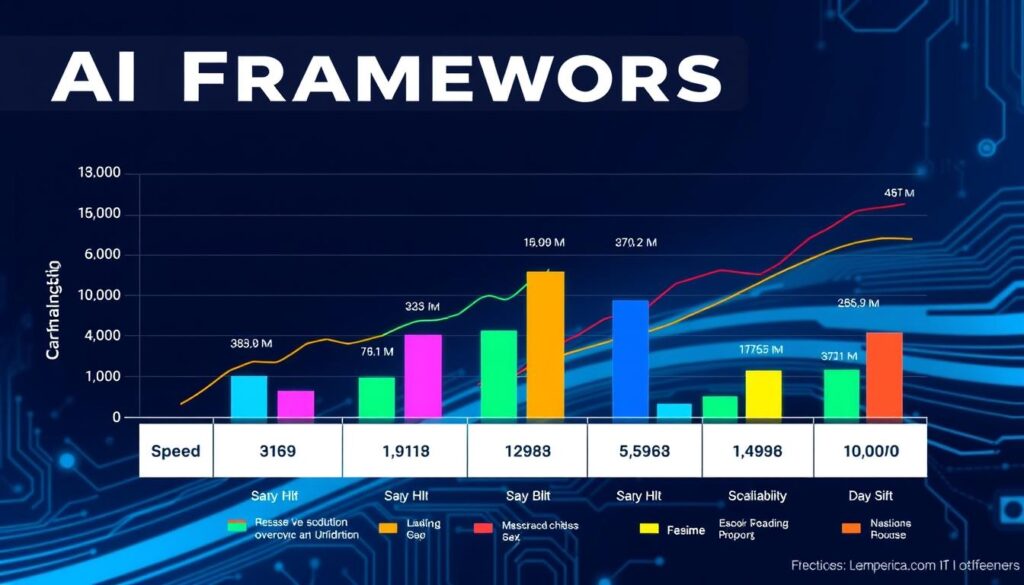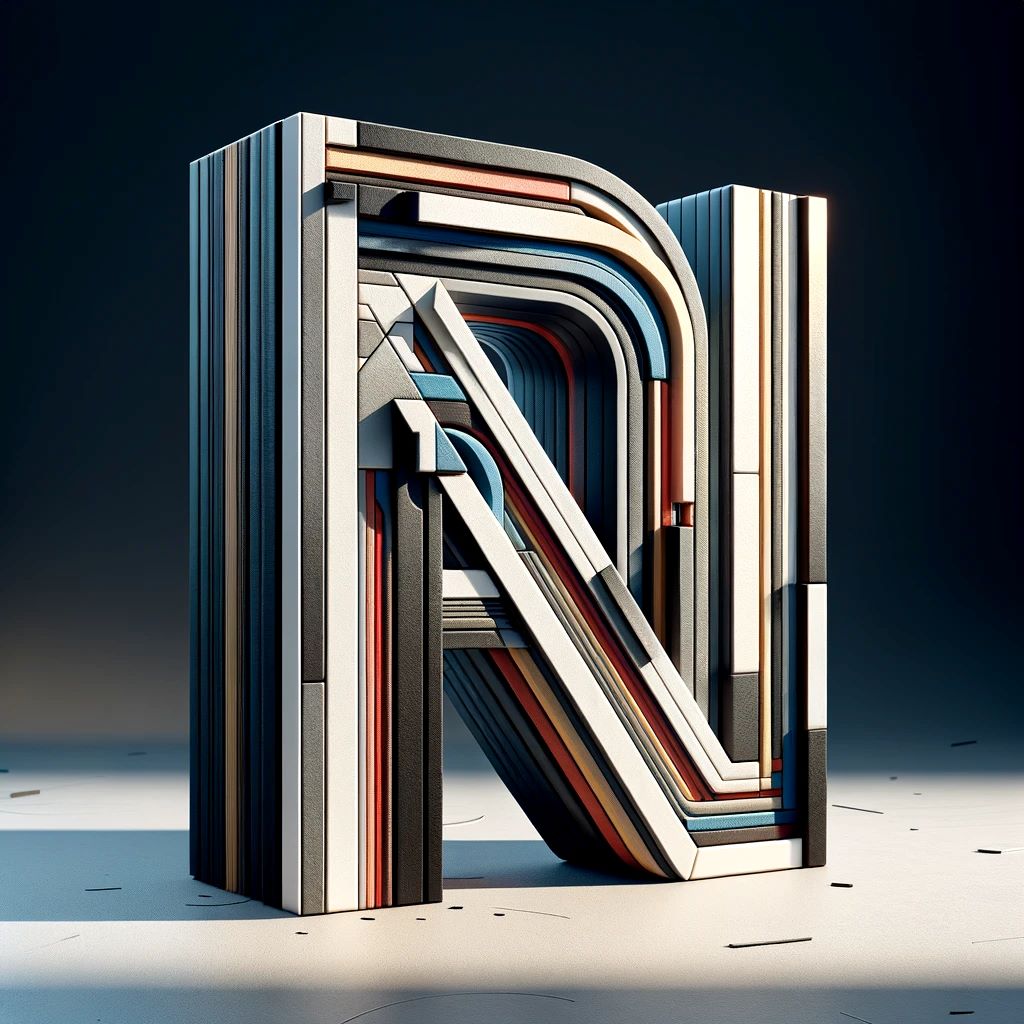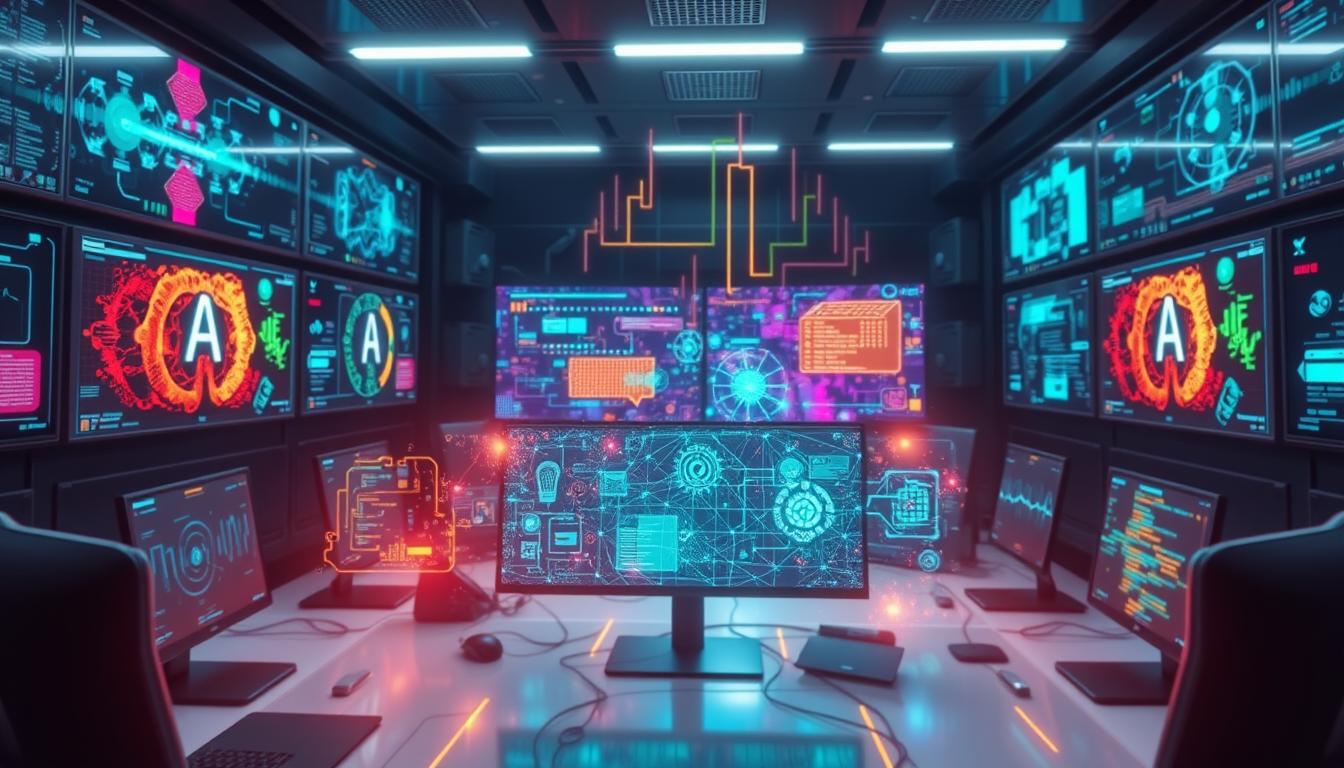“As an Amazon Associate I earn from qualifying purchases.” .
At a recent AI conference, I was amazed by chatbots that could write poetry and algorithms that predicted natural disasters. It showed how far AI has come. AI frameworks have opened up new possibilities, letting developers like us create amazing applications.
AI frameworks are key for modern machine learning and deep learning. They help us build everything from simple chatbots to complex language models. For developers, knowing these frameworks is vital to keep up with AI’s fast pace.
In this guide, we’ll look at seven top AI frameworks that are changing AI development. We’ll cover TensorFlow, PyTorch, and more. This guide will help you pick the right framework for your projects, whether you’re starting out or looking to grow your skills.
Key Takeaways
- AI frameworks are essential tools for developing machine learning and deep learning applications
- TensorFlow and PyTorch are leading frameworks for both research and production-ready AI applications
- Emerging frameworks like LangChain and LlamaIndex specialize in large language model integration
- Hugging Face Transformers offers pre-trained models for various AI tasks
- The choice of framework can significantly impact project performance and development speed
Introduction to AI Frameworks
AI frameworks are key in today’s AI world. They help build many applications, like chatbots and self-driving cars. Let’s explore what AI frameworks are and why they matter.
What is an AI Framework?
An AI framework is a software platform. It gives developers tools and components for AI apps. It makes building AI models easier with libraries, APIs, and environments.
Importance of AI Frameworks in Development
AI frameworks are vital for several reasons:
- Efficiency: They speed up development with ready components.
- Consistency: They ensure a standard approach in projects.
- Scalability: They help AI apps grow and handle big datasets.
- Community support: Popular frameworks have active communities for help and updates.
Big tech companies like Google and Microsoft use AI frameworks. Google’s TensorFlow is used by over 190,000 Alphabet employees. Microsoft, with 221,000 employees, uses various AI frameworks for its services.
| Company | Employees | Notable AI Framework |
|---|---|---|
| Google (Alphabet) | 190,234 | TensorFlow |
| Microsoft | 221,000 | Microsoft Cognitive Toolkit |
| IBM | 160,000+ | Watson Studio |
AI frameworks let developers create new solutions without starting from scratch. They are the backbone of many AI advancements. They power everything from natural language processing to computer vision.
Types of AI Frameworks
AI frameworks are key to modern artificial intelligence. They are designed for different AI tasks. Let’s look at the main types and their features.
Machine Learning Frameworks
Machine learning frameworks use algorithms to learn from data. Scikit-learn is a top choice for basic machine learning. It has tools for preparing data, choosing models, and checking results.
Deep Learning Frameworks
Deep learning frameworks focus on neural networks. Keras is known for making complex neural networks easy to use. It works well with other frameworks, making it very versatile.
Natural Language Processing Frameworks
NLP frameworks handle text and speech. The Hugging Face Transformers library has changed NLP. It offers pre-trained models for tasks like analyzing sentiment and translating languages.
Reinforcement Learning Frameworks
These frameworks help AI make decisions in changing situations. They let AI agents learn by trying things and seeing what works. This is how humans learn from experience.
| Framework Type | Popular Example | Key Feature |
|---|---|---|
| Machine Learning | Scikit-learn | Comprehensive tools for data analysis |
| Deep Learning | Keras | User-friendly neural network building |
| NLP | Hugging Face Transformers | Pre-trained models for text processing |
| Reinforcement Learning | OpenAI Gym | Simulated environments for agent training |
Each framework type is for a specific AI task. This lets developers pick the right tool for their projects. As AI grows, these frameworks are vital for creating smarter systems.
Overview of Popular AI Frameworks
AI frameworks are key to modern machine learning projects. They give developers the tools to create new solutions. Let’s look at some of the most used frameworks in AI.
TensorFlow
Google AI created TensorFlow. It’s known for being flexible and ready for production. Companies like Airbnb and Coca-Cola use it for AI models and tools.
TensorFlow’s distributed training lets you train models on different hardware setups. This makes it efficient for large projects.
PyTorch
Meta AI made PyTorch. It’s great for dynamic computation. Researchers love it for its easy design and use.
PyTorch is perfect for complex neural networks. This makes it ideal for advanced AI projects.
Keras
Keras is built on top of TensorFlow. It’s known for its easy-to-use interface. It’s great for beginners in AI.
Keras makes building and training neural networks simpler. This is why it’s popular for starting AI projects.
Scikit-learn
Scikit-learn is for traditional machine learning. It’s used for data prep, classification, regression, and clustering. Its simplicity and detailed documentation make it a favorite among data scientists.
| Framework | Key Strength | Primary Use Case |
|---|---|---|
| TensorFlow | Scalability | Large-scale deployments |
| PyTorch | Dynamic computation | Research and prototyping |
| Keras | User-friendly | Quick model development |
| Scikit-learn | Versatility | Classical ML algorithms |
Each framework has its own strengths. They cater to different needs in AI development. The right choice depends on your project and team’s skills.
TensorFlow: Features and Benefits
TensorFlow was launched in 2015 by Google Brain. It has become a key player in AI development. This open-source library has many tools for building and deploying machine learning models.
Key Features of TensorFlow
TensorFlow supports both CPU and GPU computing. It has levels of abstraction for all skill levels. Its eager execution makes it easy to iterate and debug models.
TensorBoard is a big plus. It’s a tool for debugging and optimizing performance. TensorFlow Hub also offers pre-trained models, speeding up AI development.
Use Cases for TensorFlow
TensorFlow is great for building scalable deep learning models. It shines in:
- Image recognition
- Neural machine translation
- Large-scale ML training tasks

Big names like Airbnb, Google, and Twitter use TensorFlow for AI. It’s versatile, working in many industries, from healthcare to finance.
Getting Started with TensorFlow
To start with TensorFlow:
- Install TensorFlow via pip or conda
- Check out TensorFlow’s tutorials and documentation
- Begin with simple models and grow complexity
- Use TensorBoard to see how your model performs
Remember to break your code into smaller parts. Use @tf.function decorators for better performance. With TensorFlow’s vast ecosystem and community support, you’re ready to explore AI development.
PyTorch: A Developer’s Choice
PyTorch has become a top AI framework, loved by developers and researchers. It saw a huge jump in popularity, with a 388% increase in GitHub stars from 2017 to 2018. Now, it’s second only to TensorFlow, with a 24% market share.
PyTorch Features
PyTorch stands out because of its strong features. It’s great at making dynamic computational graphs with its Autograd system. This lets developers tweak models on the fly, making AI development more flexible.
PyTorch Enterprise adds more power and support for when you’re ready to use it in production. This makes it a top pick for businesses.
Popular Applications
PyTorch is a hit in many AI areas. It’s perfect for creating generative AI models and large language models (LLMs). It also has libraries like torchvision for computer vision and torchaudio for audio.
These tools, along with PyTorch’s flexibility, make it great for research and complex tasks. It’s a favorite for tackling tough AI challenges.
Installation and Setup
Getting PyTorch up and running is easy. It works well with Python’s scientific computing tools, thanks to Python’s growth in 2017. For setup, check out the official PyTorch website.
It has clear instructions for different operating systems and preferences. With support from big names like AWS, AMD, Google, and Microsoft, PyTorch keeps improving. It’s helping make new AI discoveries and research possible.
Keras: Simplifying Neural Networks
Keras is a powerful tool for building neural networks. It’s a high-level neural networks API that makes creating complex models easy. It helps developers focus on innovation, not technical details.
What Makes Keras Unique?
Keras is known for its simplicity and flexibility. It supports both convolutional and recurrent networks. This makes it great for many deep learning tasks. Its user-friendly interface is perfect for beginners and experienced developers alike.
| Feature | Benefit |
|---|---|
| User-friendly API | Rapid prototyping |
| Modular architecture | Flexible model creation |
| Extensive documentation | Easy learning curve |
| Multiple backend support | Versatility in deployment |
Integrating Keras with Other Frameworks
Keras works well with TensorFlow. It offers an easy-to-use interface while using TensorFlow’s strong features. This makes creating complex neural networks easier.
Sample Projects Using Keras
Keras is great for many projects. Here are some examples:
- Image classification using convolutional networks
- Sentiment analysis with recurrent networks
- Time series prediction using LSTM layers
- Text generation with transformer models
These projects show Keras’s ability to handle different neural network types. Its API lets developers build complex models quickly. This speeds up the development process.
Scikit-learn: The Go-To for Machine Learning
Scikit-learn is a top tool in classical machine learning. It has many tools for data mining and analysis. This makes it a favorite among developers and data scientists.
Overview of Scikit-learn
Scikit-learn is great for traditional machine learning tasks. It has tools for data prep, model selection, and evaluation. It works well with libraries like NumPy and SciPy for structured data.
Key Features
Scikit-learn has many features for machine learning:
- Comprehensive algorithm coverage (classification, regression, clustering)
- Robust tools for data preprocessing and feature selection
- Efficient model evaluation techniques
- Excellent documentation and community support
When to Use Scikit-learn
Scikit-learn is best for classical machine learning projects. It’s great for tasks like:
| Task | Description |
|---|---|
| Classification | Predicting categories for new data points |
| Regression | Estimating continuous values |
| Clustering | Grouping similar data points |
| Dimensionality Reduction | Reducing the number of features in a dataset |
For projects with structured data or no deep learning needs, Scikit-learn is key. Its easy-to-use interface and efficient algorithms make it a top pick for machine learning experts and beginners alike.
Comparison of AI Frameworks
When picking an AI framework, developers must think about several things. Let’s look at what makes these frameworks different.
Performance Metrics
AI performance is key. TensorFlow and PyTorch stand out in benchmark tests for deep learning. They are fast at training and running models, ideal for big projects.

Ease of Use
Keras and Scikit-learn are great for beginners. They make starting easy and fast. But, experts often choose TensorFlow or PyTorch for more control.
Community Support
A big community can really help a framework. TensorFlow and PyTorch have huge, active groups. This means better documentation quality and lots of help for learning and fixing issues.
| Framework | Performance | Ease of Use | Community Support |
|---|---|---|---|
| TensorFlow | High | Moderate | Strong |
| PyTorch | High | Moderate | Strong |
| Keras | Moderate | High | Good |
| Scikit-learn | Moderate | High | Good |
An ecosystem comparison shows each framework’s strengths. TensorFlow is best for production, while PyTorch is great for research. Keras is simple, and Scikit-learn is best for traditional machine learning. Your choice depends on your project and team skills. For better AI workflows, check out AI optimization algorithms to boost efficiency.
Choosing the Right AI Framework for Your Project
Choosing the right AI framework is key to your project’s success. It’s important to consider several factors before deciding. Let’s look at the main points and how to pick a framework that fits your needs.
Factors to Consider
Project complexity is a big factor in choosing an AI framework. Simple projects might need basic frameworks, while complex ones require more advanced ones. Your team’s programming skills also matter. Some frameworks are easier for beginners, while others are better for experienced programmers.
How well the framework works with your current tools and data is also important. Think about how much data you’ll be handling and if you need real-time processing.
Evaluating Frameworks Based on Project Needs
To pick the right framework, make a list of what your project needs. Check if the framework supports your team’s main programming language. Also, see if it fits your data processing and AI task needs, like natural language or computer vision.
| Framework | Best For | Key Feature | Complexity Level |
|---|---|---|---|
| TensorFlow | Large-scale deployments | Scalability | High |
| PyTorch | Research and prototyping | Flexibility | Medium |
| Keras | Quick model development | Simplicity | Low |
| Scikit-learn | Traditional ML tasks | Wide algorithm selection | Low to Medium |
The best framework matches your project’s goals, your team’s skills, and your organization’s technology. Take time to try out different options and talk with your team before deciding.
Future Trends in AI Frameworks
AI frameworks are changing fast, shaping the future of tech. These changes open up new areas in edge computing, federated learning, and AutoML.
Evolution of Frameworks
The world of AI frameworks is rapidly evolving. Generative AI is getting more attention, thanks to big investments. This is leading to new tools for creating text, videos, images, and audio.
Multimodal AI models are also becoming popular. They mix different data types for better results. This is a big step forward.
Edge computing is now a major focus. AI frameworks can now run on devices with limited resources. This lets AI work in places without internet.
Federated learning is another trend growing fast. It trains models on many devices, keeping data safe and private.
Impact of New Technologies
AutoML is changing how we develop AI. It’s being added to frameworks to make model selection and fine-tuning easier. This makes AI more accessible to developers of all levels.
- NLP improves customer interactions through automated service
- Explainable AI enhances trust in AI decisions
- AI-powered job search tools suggest the best matches for job seekers
The democratization of AI is happening fast. Tools like ChatGPT are growing quickly, reaching millions of users fast. This trend will keep going, making AI more available to everyone.
Best Practices for Using AI Frameworks
Success in AI development depends on following best practices. A survey by CDO Magazine shows 60% face challenges due to limited skills and resources. Let’s look at strategies to overcome these hurdles.
Coding Standards
Consistent coding standards are key. Use version control for code and models to track changes. This keeps code quality high and helps teams work together smoothly.
Documentation and Maintenance
Good documentation is vital for AI projects. CDO Insights 2024 says organizations need at least five tools for AI model management. Make detailed guides for data pipelines, model architectures, and deployment. This ensures knowledge is shared and maintenance is easier.
Testing Strategies
Testing AI frameworks well is essential. Use continuous integration to find problems early. Create unit tests for parts and integration tests for the whole system. Regular testing keeps models working well and lowers the chance of surprises.
Model versioning is key for reproducibility. Keep track of model changes to replicate results and roll back if necessary. This is important, as 41% of data leaders manage over 1,000 data sources.
| Practice | Benefit | Implementation |
|---|---|---|
| Version Control | Improved collaboration | Git, MLflow |
| Continuous Integration | Early bug detection | Jenkins, GitLab CI |
| Model Versioning | Reproducibility | DVC, Weights & Biases |
By adopting these best practices, you can improve your AI development. This ensures you meet regulations like the EU AI Act. You’ll create more reliable and maintainable AI systems.
Conclusion: The Road Ahead for AI Development
The world of AI frameworks is changing fast. Tools like TensorFlow, PyTorch, and Keras are leading the way. They’re not just tools; they’re key to AI progress in many fields.
Recap of Key Points
AI is changing healthcare with better diagnostics and personalized care. In finance, AI is fighting fraud and improving credit scores. The manufacturing and retail sectors are also seeing big changes thanks to AI.
These changes show how important AI frameworks are. They help drive progress in many areas.
Encouragement for Continuous Learning
The AI world is always changing, with new technologies coming up all the time. To keep up, developers need to keep learning. This means learning about current and new frameworks like LangChain and LlamaIndex.
By staying curious and open to new ideas, developers can help solve big problems. These include climate change and making sure everyone has enough food.
FAQ
What is an AI framework?
What are the main types of AI frameworks?
What are some popular AI frameworks?
What are the key features of TensorFlow?
What makes PyTorch unique?
What are the advantages of using Keras?
When should I use Scikit-learn?
How do I choose the right AI framework for my project?
What are some future trends in AI frameworks?
What are some best practices for using AI frameworks?
“As an Amazon Associate I earn from qualifying purchases.” .



